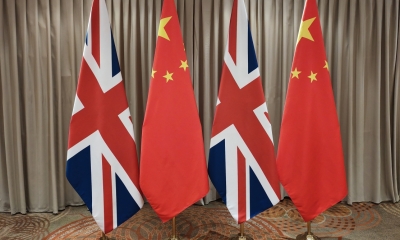China Highlights Innovation & Consumption to Avoid Middle-Income Trap

China’s new 14th Five Year Plan aims to chart a new course for its economic development, one that maximises innovation, domestic consumption and international trade. But is it enough to ensure it avoids economic stagnation associated with the middle-income trap?
China’s top legislature concluded its most important annual session on March 11, outlining the future direction of the country’s development.
The 14th Five-Year Plan (2021-2025) passed during the fourth session of the 13th National People’s Congress (NPC) aims to make a key step for China to achieve its goal of socialist modernization in all respects by 2035, which could be equivalent of a medium developed country in terms of per capita income.
All eyes will be on how the document will deliver on these promises, and especially on how it will accomplish something only a handful of countries have managed in the last half century: breaking past the middle-income trap.
Used to describe a country’s delayed jump from middle-income status to high-income status, the middle-income trap is something China has attempted to hurdle over the past two decades, and is a challenge that must be overcome if it is to realize its newly acquired goals.
Analysts have been clear that the next 15 years are crucial to China’s future development, stating it must achieve GDP growth of more than 5 percent over the next five years if it is to ensure a smooth transition that has so far snared middle-income countries since the 1960s.
The current coronavirus pandemic, rising tensions with the United States and growing issues with precuring technology have only made the task more difficult. So how does China’s 14th FYP expect to achieve it?
Innovation, innovation, innovation
The first key initiative is an acceleration in innovation. China’s new FYP aims to pursue “innovation-driven development”, including the strengthening of science and technology areas, making breakthroughs in core technologies, and increasing R&D spending by more than seven percent per year, according to goals in the Government Work Report that supplement the FYP.
Upgrading traditional industries and strengthening areas like the digital economy have been mentioned by analysts as an essential move in realizing a high-income economy, and are an area that countries like Brazil have failed to rectify in their pursuit of moving into the higher bracket.
China however appears in no mood to repeat the same mistake. The Government Work Report delivered by Premier Li Keqiang on March 5 mentioned the term “innovation” 33 times, as well as “technology” and “technological” a combined 33 times, highlighting how policies related to these concepts will be placed at the heart of the government plans.
This boost in innovation will help create essential technologies needed for China’s development, including semiconductors and chips, helping it to become more self-sufficient in the field of technology.

Creating super-spenders
Increased innovation however is only one part of the plan, or the supply side of it. Along with the production of higher-quality products and services, the creation of a “strong domestic market” to expand China’s “domestic demand”, or the demand side, has also been deemed essential.
In the US, domestic consumption is key, making up close to 87 percent of its entire economy but in China that figure is significantly smaller, with domestic consumption contributing less than 60 percent – 57.8 percent in 2019 and 54.3 percent in 2020 – to its economy.
The 14th FYP therefore aims to address this problem and create a “super-sized domestic market”, one that can properly harvest the spending power of its 400 million strong middle class. China’s large population is at times its biggest asset, and the new five-year plan looks to utilize it even further, reforming the legal process of turning migrant workers into city dwellers by making it easier for them to earn household registration permits – known as hukou’s – which will in turn lead to an even bigger middle class and stronger consumer market.
Policies are also being created to ensure the millions of citizens who’ve recently been lifted out of poverty continue to enjoy greater economic opportunities, thus increasing their personal and disposable income, and creating an even larger army of super-spenders.
External markets still key
Releasing the full power of its domestic market does not however mean forsaking what made China the economic power-house that it is today. Exports have since the 1980s been essential in China’s economic growth.
Instead, the 14th FYP aims for exports to stand side by side with domestic consumption as part of a policy known as “dual circulation”, whereby both “internal” and “external” circulation of capital combine to create a complete economic platform.
And rather than retreating away from the international market, China’s 14th FYP aims to increase “both the quality and quantity” of imports and exports, as well as a greater pursuit of “high-standard opening-up”. Greater market access for international companies is set to improve, as is a further reduction in its negative list. Promoting fairer opportunities and opening-up more sectors of the economy to international economic cooperation is also set to continue.
Building on the work of last year, in which China joined RCEP and signed an investment agreement with the European Union, plans are in place to step-up negations and sign free-trade agreements with Japan, Republic of Korea, as well as exploring what opportunities the Comprehensive and Progressive Agreement for Trans-Pacific Partnership can offer it.
The world waits expectedly
The 14th FYP therefore aims to chart a new course for China’s economic strategy, one that maximises innovation, domestic and external markets. Key to ensuring it can deliver its long-term goals will be its transformation into a high-income country, and it therefore needs to shake off the shackles that come with being ensnared by the middle-income trap as soon as possible.
For the global economy, it is essential China makes this leap, with the country now responsible for 17 percent of the world’s economy and an essential cog in the global supply chain. As the only major economy to experience economic growth last year, global markets need a high-income China.
China often under promises and over delivers in its FYP, meaning there is great expectation that its latest plan is well placed to be delivered over the next five years.
 Facebook
Facebook
 Twitter
Twitter
 Linkedin
Linkedin
 Google +
Google +







